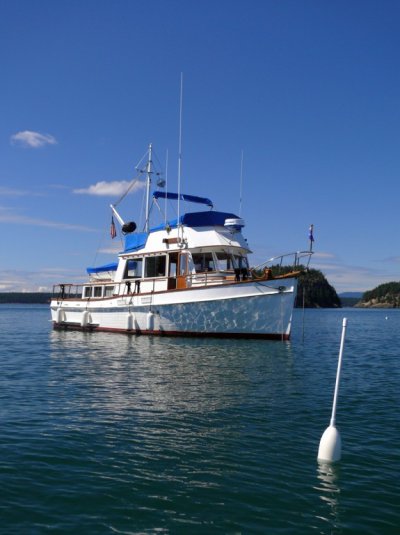- Joined
- Jun 25, 2008
- Messages
- 10,104
- Location
- Australia
- Vessel Name
- Now boatless - sold 6/2018
- Vessel Make
- Had a Clipper (CHB) 34
PS, I wrote this post about the same time Rex was writing his by the looks, so it was not there when I started...but you have to admit we are consistent...
I wasn't going to get into this any more, but I have to ask just this one last question Marin. Did you actually read what I said last post, (carefully), and have you actually looked at my pics closely - thinking about the laws of physics involved? Then, after doing so, please explain, (thinking here of these people you know, who allege their anchor backed out because of the slot and nearly saw them wrecked on a lee shore), how is it a shackle can slide back up a shank towards the fluke, in a slot, (no matter how badly designed), when there a several tons of tension pulling it in the opposite direction?
The only way a shackle can be induced to slide back along the slot is when it is virtually in-line, virtually vertically above, and under very light tension - otherwise it won't - anything more and it jams in position, and just pulls on the shank, like any other end fixed anchor chain would do - simple as that. As to seeing the marks on the shank - sorry, but balderdash....I've been tripping my anchor deliberately for years, as I said before, and you cannot see shackle marks on the slot, so if they say they can...or if they actually found the shackle jammed at the wrong end, then it says something about the design of the slot, or the slot shackle combination they were using was wrong, (and it is important that coupling is correct and to manufacturer recommendations - feel free to correct me if I'm wrong here Rex), and therefore the anchor was prevented somehow (jammed most likely) from re-setting as it should as soon as tension went on it as the wind turned and it became a lee shore....
In a bay tidal currents are never straight in and straight out, and wind angles similarly drift around, so the only way an anchor slot could trip an anchor is in the freakishly unlikely event of the wind being so light, that whatever wind/tide combination moved the boat, it drifted right back over the anchor in perfect alignment with the shank towards the fluke end, and without any sideways pull, and nothing on the bottom deflecting the shackle end of the chain more than a few centimeters. How likely is that...and in those conditions - if it ever happened - who cares - you would not even know, and if the wind came up, any decent roll bar anchor, like your Rocna or a Sarca, would re-set so quick you would not notice. Just think of the physics and look at the pics, and tell me that ain't so....
-- Edited by Peter B on Friday 24th of February 2012 06:45:28 PM
I wasn't going to get into this any more, but I have to ask just this one last question Marin. Did you actually read what I said last post, (carefully), and have you actually looked at my pics closely - thinking about the laws of physics involved? Then, after doing so, please explain, (thinking here of these people you know, who allege their anchor backed out because of the slot and nearly saw them wrecked on a lee shore), how is it a shackle can slide back up a shank towards the fluke, in a slot, (no matter how badly designed), when there a several tons of tension pulling it in the opposite direction?
The only way a shackle can be induced to slide back along the slot is when it is virtually in-line, virtually vertically above, and under very light tension - otherwise it won't - anything more and it jams in position, and just pulls on the shank, like any other end fixed anchor chain would do - simple as that. As to seeing the marks on the shank - sorry, but balderdash....I've been tripping my anchor deliberately for years, as I said before, and you cannot see shackle marks on the slot, so if they say they can...or if they actually found the shackle jammed at the wrong end, then it says something about the design of the slot, or the slot shackle combination they were using was wrong, (and it is important that coupling is correct and to manufacturer recommendations - feel free to correct me if I'm wrong here Rex), and therefore the anchor was prevented somehow (jammed most likely) from re-setting as it should as soon as tension went on it as the wind turned and it became a lee shore....
In a bay tidal currents are never straight in and straight out, and wind angles similarly drift around, so the only way an anchor slot could trip an anchor is in the freakishly unlikely event of the wind being so light, that whatever wind/tide combination moved the boat, it drifted right back over the anchor in perfect alignment with the shank towards the fluke end, and without any sideways pull, and nothing on the bottom deflecting the shackle end of the chain more than a few centimeters. How likely is that...and in those conditions - if it ever happened - who cares - you would not even know, and if the wind came up, any decent roll bar anchor, like your Rocna or a Sarca, would re-set so quick you would not notice. Just think of the physics and look at the pics, and tell me that ain't so....
-- Edited by Peter B on Friday 24th of February 2012 06:45:28 PM

